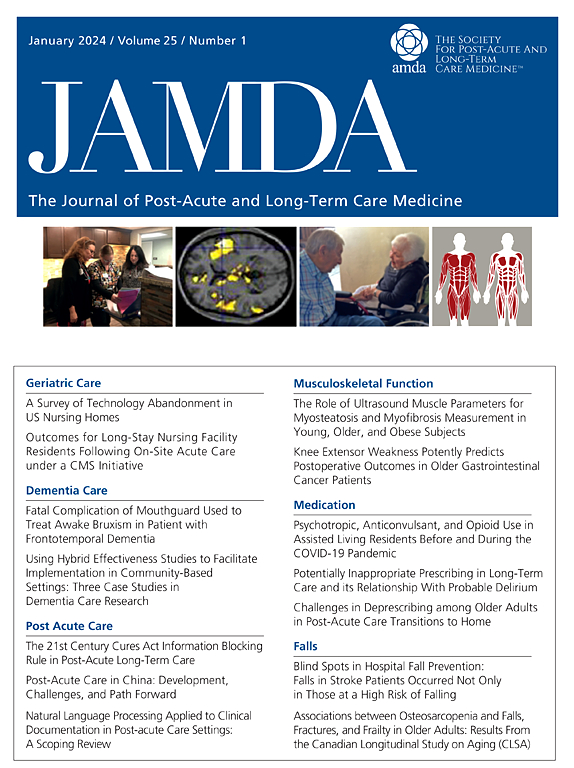医疗保险D部分协议和最低数据集报告疗养院精神药物使用。
IF 4.2
2区 医学
Q2 GERIATRICS & GERONTOLOGY
Journal of the American Medical Directors Association
Pub Date : 2025-04-14
DOI:10.1016/j.jamda.2025.105538
引用次数: 0
摘要
目的:很少有证据表明基于最小数据集(MDS)的药物项目的准确性。我们比较了2018年MDS和D部分事件文件(PDE)之间抗精神病药、抗抑郁药和催眠药的季度使用率。设计:横断面比较。环境和参与者:包括所有美国医疗保险或医疗补助认证的养老院。在医疗保险D部分登记的长期护理之家居民,年龄≥65岁,MDS数据中确定有精神疾病或痴呆(N = 580,340)。两个亚队列包括:有精神障碍但没有阿尔茨海默病和相关痴呆(ADRD)的居民,以及有ADRD的居民。方法:使用MDS确定的季度中接受药物治疗的研究参与者的比例来评估精神药物的使用情况。我们使用Cohen kappa来评估本季度使用精神药物的居民比例的一致性,并使用PDE数据作为计算效度参数的参考。结果:通过kappa值测量,MDS报告和PDE报告的抗精神病药(MDS vs PDE: 34.0% vs 34.3%)或抗抑郁药(MDS vs PDE: 73.4% vs 71.3%)使用者具有高一致性(抗精神病药:0.9;抗抑郁药:0.83)。与PDE相比,MDS数据的敏感性、特异性、阳性预测值和阴性预测值在抗精神病药方面分别为96.7%、92.8%、96.3%和93.6%,在抗抑郁药方面分别为84.5%、96.7%、91.1%和94.0%。MDS数据中只有3.7%的研究参与者使用催眠药,而基于pde的用户中有32.6% (kappa值:0.1)使用催眠药。抗焦虑药物与催眠药物合用后,MDS患者使用催眠或抗焦虑药物的比例增加到35.0% (kappa值为0.74)。敏感性为89.5%,特异性为85.6%,阳性预测值为92.8%,阴性预测值为79.8%。结论和意义:MDS和PDE在抗精神病药和抗抑郁药使用方面的一致性很高,表明MDS是衡量抗精神病药和抗抑郁药使用情况的有效工具。需要进一步的工作来了解MDS和PDE在催眠使用中的差异。本文章由计算机程序翻译,如有差异,请以英文原文为准。
Agreement of Medicare Part D and Minimum Data Set Reported Psychotropic Medication Use in Nursing Homes
Objectives
Little evidence exists on the accuracy of the Minimum Data Set (MDS)–based medication items. We compared quarterly rates of antipsychotic, antidepressant, and hypnotic use between the MDS and Part D Prescription Drug Event file (PDE) in 2018.
Design
Cross-sectional comparison.
Setting and Participants
All US Medicare- or Medicaid-certified nursing homes were included. Long-stay nursing home residents enrolled in Medicare Part D who were aged ≥65 years with psychiatric disorders or dementia identified in the MDS data (N = 580,340) were included. Two subcohorts included the following: residents with psychiatric disorders and no Alzheimer's disease and related dementias (ADRD), and residents with ADRD.
Methods
Psychotropic medication use was assessed using the share of study participants who received the medication in the quarter identified by the MDS. We used Cohen kappa to assess agreement in the share of residents using psychotropic medications during the quarter and used PDE data as a reference to calculate validity parameters.
Results
The MDS-reported and PDE-reported antipsychotic (MDS vs PDE: 34.0% vs 34.3%) or antidepressant (MDS vs PDE: 73.4% vs 71.3%) users have high concordance as measured by the kappa value (antipsychotic: 0.9; antidepressant: 0.83). Sensitivity, specificity, positive predictive value, and negative predictive value of MDS data compared with PDE were 96.7%, 92.8%, 96.3%, and 93.6% for antipsychotic, and 84.5%, 96.7%, 91.1%, and 94.0% for antidepressant. Only 3.7% of study participants identified in the MDS data, vs 32.6% of PDE-based users (kappa value: 0.1), used hypnotics. By combining antianxiety medications with hypnotics, the rates of MDS hypnotic or antianxiety users increased to 35.0% (kappa value: 0.74). Sensitivity, specificity, positive predictive value, and negative predictive value were 89.5%, 85.6%, 92.8%, and 79.8%, respectively.
Conclusions and Implications
Agreement between the MDS and PDE in antipsychotic and antidepressant use was high, suggesting that the MDS is a valid tool to measure antipsychotic and antidepressant use. Additional work is needed to understand the disagreements between MDS and PDE in hypnotic use.
求助全文
通过发布文献求助,成功后即可免费获取论文全文。
去求助
来源期刊
CiteScore
11.10
自引率
6.60%
发文量
472
审稿时长
44 days
期刊介绍:
JAMDA, the official journal of AMDA - The Society for Post-Acute and Long-Term Care Medicine, is a leading peer-reviewed publication that offers practical information and research geared towards healthcare professionals in the post-acute and long-term care fields. It is also a valuable resource for policy-makers, organizational leaders, educators, and advocates.
The journal provides essential information for various healthcare professionals such as medical directors, attending physicians, nurses, consultant pharmacists, geriatric psychiatrists, nurse practitioners, physician assistants, physical and occupational therapists, social workers, and others involved in providing, overseeing, and promoting quality

 求助内容:
求助内容: 应助结果提醒方式:
应助结果提醒方式:


